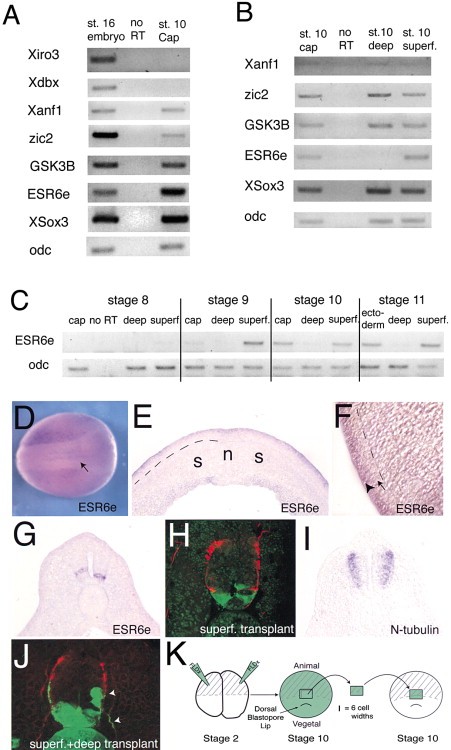XB-IMG-46972
Xenbase Image ID: 46972

|
Figure 6. Expression of Genes that May Inhibit Neuronal Differentiation in the Superficial Layer(A) Expression of candidate genes in isolated stage 10 animal caps by RT-PCR.(B) Expression of candidate genes in deep and superficial layers isolated from stage 10 animal caps by RT-PCR. Only ESR6e expression was restricted to the superficial layer.(C) Expression of ESR6e in separated deep and superficial layers at blastula and gastrula stages by RT-PCR. ESR6e is not maternally expressed, but its expression is restricted to the superficial layer from the onset of zygotic transcription.(D) Expression of ESR6e at the neurula stage by whole-mount in situ hybridization. Expression is stronger in the epidermal ectoderm and in a bilateral row of cells flanking the midline (arrow).(E) Sections of neurula stage embryo showing expression of ESR6e throughout the superficial layer of the ectoderm.(F) High magnification of (E), showing ESR6e expression in the superficial layer of epidermal ectoderm (arrowhead) but not in the deep layer (arrow). In (E) and (F), a dashed line separates the ectoderm from underlying mesoderm.(G) Section of stage 23 embryo showing expression of ESR6e in the ventro-lateral neural tube. This expression may originate from an earlier expression in cells flanking the midline (arrow in Figure 6D).(H) Superficial layer transplants (see [K]) give rise to elongated cells that maintain apical-basal contact. No axons and no apically withdrawn cells were observed in 6/6 embryos. In this and in (J), neuronal processes are shown in red.(I) Expression of N-tubulin at stage 23.(J) Whole ectoderm transplant (see [K]). Some cells have withdrawn apical (ependymal) contacts and extended axons (arrows).(K) Diagram of the homotypic, isochronic, transplantation of FLDx-labeled ectoderm (green) into unlabeled host (see Supplemental Data [http://www.developmentalcell.com/cgi/content/2/2/171/DC1]). Abbreviations are as follows: cap, whole animal cap ectoderm; deep, deep layer ectoderm; n, notochord; superf., superficial layer ectoderm; s, somite. Image published in: Chalmers AD et al. (2002) Copyright © 2002. Image reproduced with permission of the Publisher, Elsevier B. V.
Image source: Published Larger Image Printer Friendly View |
